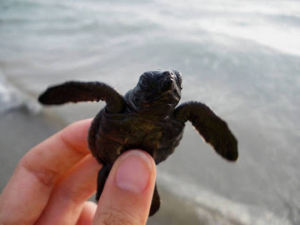Human intervention helps bring back the Kemp’s Ridley sea turtles
April 5, 2013
The Kemp’s Ridley sea turtles, lepidochelys kempii, are currently listed as critically endangered.
Judy Scherff, an adjunct biology professor at Washburn, gave a seminar about these turtles March 25, 2013. She talked about the Kemp’s Ridley’s biology, and their future as a critically endangered species. She illustrated the efforts of a conservation organization called Sea Turtle Inc., which manages a rescue and research facility in South Padre Island, Texas. She showed the direct threats on the turtles, such as disturbing of nests by poachers or predators, and most of all the accidental by-catch of the turtles in fishing nets, and how indirect stressors like loss of nesting habitat due to local development, pollution and global warming contribute to the rapid decline of these animals.
She demonstrated the involvement of the South Padre Rescue facilities and introduced the students to some of the rescued residents currently held at that facility. She explained the program at the station from scheduled releases, to the adoption program of nests, and pointed out that there are internship possibilities and volunteer work that Washburn students can participate in at Sea Turtle Inc.
“It will tell our students the world is larger than Kansas,” said Ursula Jander, Emerita in the Washburn biology department. “They will learn research methods, nature observation, the appreciation of nature and life, and learn social experience as a group.”
It was discussed at the seminar that there is the opportunity for Washburn Students to become involved by adopting a nest and by helping as volunteers during the nesting season.
“Adopting a nest is awesome, and it helps save the turtles,” said Chelsea Sevigny, senior biology major. “It was awesome that we raised the money so fast.”
Within one week the $100 needed to adopt a nest was raised by the biology club at Washburn University.
“I would love to go during spring break cleaning up the beaches, because the turtles are not born yet,” said Sevigny.
A trip during the summer would allow the students to learn how to work with these animals hands on, give them medical care and teach them how to do nest conservation.
“I love the idea of getting involved with the little turtles,” said Sevigny. “I can get the biology club involved, if I become president of the biology club. I want to get students and faculty excited about it.”
Even a mid-western university like Washburn can make an association with the ocean.
“We are landlocked here in Kansas, and we have no connection with the sea,” said Scherff. “We have so much going on in the ocean and it is a very critical part of our ecosystem. It is easy to forget the ocean when you are far from it, but nevertheless it is very critically.”
Until the 1970s the turtles have been in rapid decline, but with help from organizations like Sea Turtle Inc. and volunteers, their numbers are slowly increasing, improving the specie’s chance for survival. Before the human intervention, the hatchling survival rate was one in 1,000 but with human help the survival rate increased to one in 300.
“We caused their near demise, by poaching the eggs and killing the turtles,” said Scherff. “And just like our actions nearly sent them into extinction, our actions can bring them back and they have been shown to do just that.”



